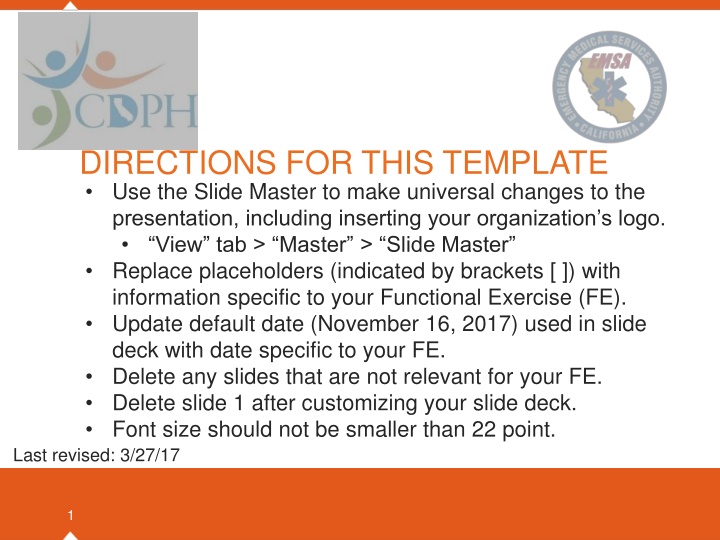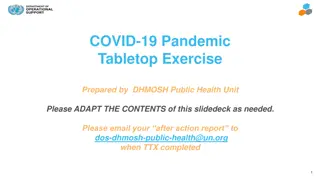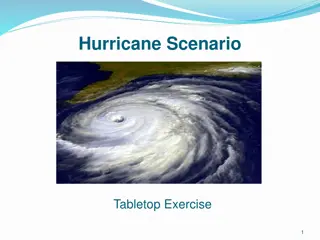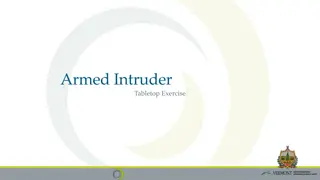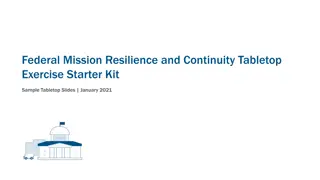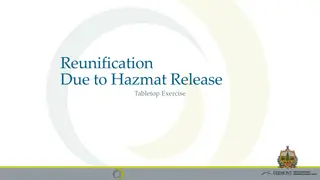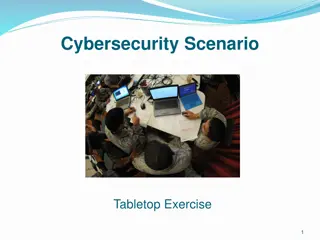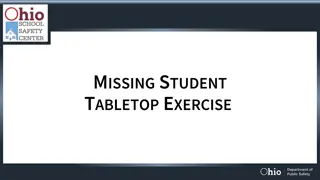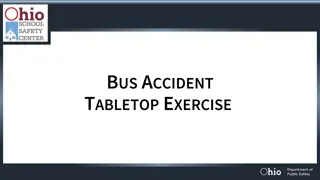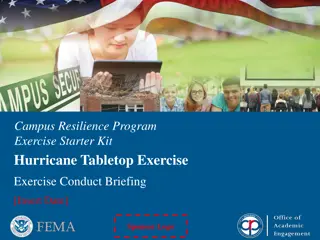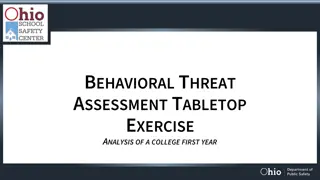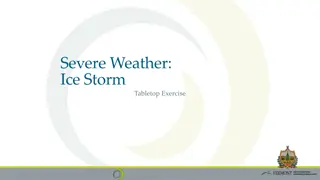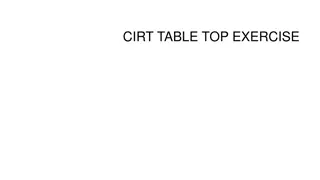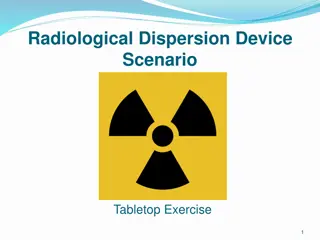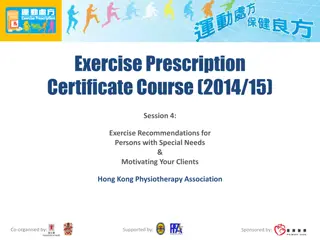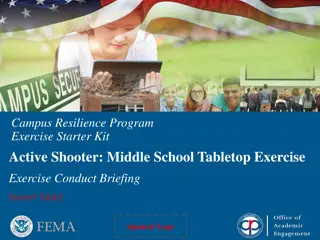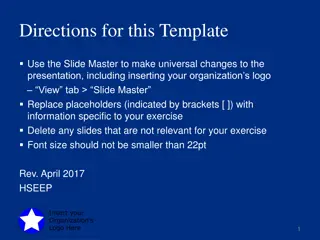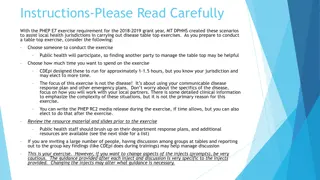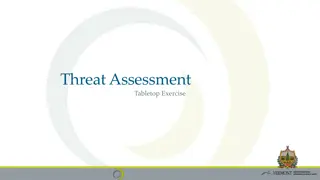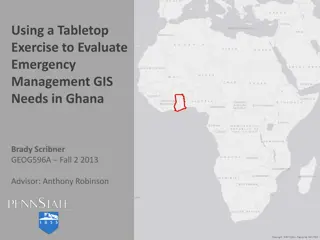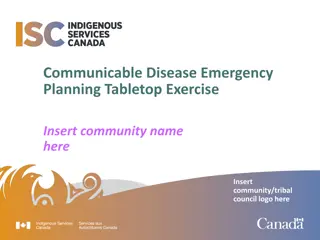Statewide Medical & Health Tabletop Exercise Phase III
This template provides guidance for organizing a functional exercise focused on medical and health emergency preparedness. It includes instructions for customizing the slide deck, updating information specific to the exercise, and conducting the tabletop exercise efficiently. The slides cover topics such as welcome and introductions, exercise overview, administration details, and key exercise materials. Use this template to create a comprehensive presentation tailored to your organization's needs and requirements.
Download Presentation

Please find below an Image/Link to download the presentation.
The content on the website is provided AS IS for your information and personal use only. It may not be sold, licensed, or shared on other websites without obtaining consent from the author.If you encounter any issues during the download, it is possible that the publisher has removed the file from their server.
You are allowed to download the files provided on this website for personal or commercial use, subject to the condition that they are used lawfully. All files are the property of their respective owners.
The content on the website is provided AS IS for your information and personal use only. It may not be sold, licensed, or shared on other websites without obtaining consent from the author.
E N D
Presentation Transcript
DIRECTIONS FOR THIS TEMPLATE Use the Slide Master to make universal changes to the presentation, including inserting your organization s logo. View tab > Master > Slide Master Replace placeholders (indicated by brackets [ ]) with information specific to your Functional Exercise (FE). Update default date (November 16, 2017) used in slide deck with date specific to your FE. Delete any slides that are not relevant for your FE. Delete slide 1 after customizing your slide deck. Font size should not be smaller than 22 point. Last revised: 3/27/17 1
[INSERT YEAR] STATEWIDE MEDICAL AND HEALTH EXERCISE PHASE III: TABLETOP EXERCISE [Exercise Name / Exercise Date]
WELCOME & OVERVIEW Welcome Name Position Agency/Organization Optional: Icebreaker Logistics Materials Situation Manual Follow along! Feedback Form Observer Handout Player Handout ? DRAFT 2017 STATEWIDE MEDICAL AND HEALTH EXERCISE SITUATION MANUAL ? TABLETOP EXERCISE 4
ADMINISTRATION ADMINISTRATION Exercise Materials Breakout Discussion Groups Parking Validations Mobile Phones Evacuation Procedure THIS IS NOT A DRILL 5
EXERCISE OVERVIEW & GENERAL INFORMATION KEY MATERIAL
EXERCISE OVERVIEW Name Statewide Medical & Health Tabletop Exercise Date [insert date] Scope 4 phases in program Mission Areas [insert selected] Capabilities [insert selected Public Health Emergency Preparedness , Health Care Preparedness and Response, or Core Capabilities] 7
EXERCISE OVERVIEW Objectives [Insert selected] Threat/Hazard [Insert selected] Scenario [Insert selected] Sponsor California Department of Public Health, Emergency Medical Services Authority, [insert your agency/organization] Participating Organizations [Insert] 8
GENERAL INFORMATION GENERAL INFORMATION Participant Roles & Responsibilities Players: Respond to situation presented based on current plans, policies, and procedures Observers: Visit or view selected segments of the exercise , but do not participate in moderated discussion Facilitators: Provide situation updates and moderate discussions Evaluators: Observe and document player discussions Controllers (if applicable): Control delivery of injects to exercise players 9
GENERAL INFORMATION Tabletop Exercise Structure [Scenario Description] Breakout group discussion and group presentations 10
GENERAL INFORMATION Exercise Guidelines Open, low-stress, no-fault environment Varying viewpoints are expected Use current plans/capabilities Consider different and innovative approaches Issue identification is not as valuable as recommended actions and improvements 11
GENERAL INFORMATION Assumptions The exercise is conducted in a no-fault learning environment wherein capabilities, plans, systems, and processes will be evaluated The exercise scenario is plausible, and events occur as they are presented Artificialities Impacts across the response community Some time lapses may be artificially used to achieve the exercise objectives See page [insert] of your Situation Manual for more Assumptions & Artificialities 12
GENERAL INFORMATION Exercise Evaluation Participant Feedback Forms Exercise Evaluation Guides Hot Wash Notes Notes from today s exercise may be used to design and implement the Functional Exercise (FE) 13
BACKGROUND INFORMATION Responding Departments/ Agencies can include: Emergency Medical Services (EMS) / Ambulance Fire Police Search & Rescue Healthcare facilities Media Non Profit Organizations Public Health 15
BACKGROUND INFORMATION Will there be enough: Staff? Space? Supplies & Equipment? System? (i.e., patient tracking) Special considerations: Media Public Response Hazardous Materials Behavioral Health 16
Pre Incident Information [One Month Pre Exercise] Several reports surface detailing a large number of cases of an influenza-like illness (ILI) in South America. The first reports come from Guyana, and within a week there are reports from Suriname and Brazil. It is unclear, at this time, whether the symptoms are indicative of a novel influenza strain, part of a particularly bad flu season, or something else. A 29-year-old female and her 33-year-old boyfriend present to [a local walk-in clinic] in [your jurisdiction]. Both patients report flu-like symptoms, including headaches, body aches, and fevers of over 101 F persisting for three days. The male reports a mild dry cough and shortness of breath. The couple is discharged the same day. In Brazil, the first fatality is reported of a 47-year old female who was admitted to the hospital with the symptoms, including high fever, headache, and pneumonia. The 33-year old male presents to [a local emergency department (ED)] two days after his visit to the walk-in clinic, reporting a worsening of symptoms, particularly his cough and shortness of breath. An x-ray is done revealing pneumonia. He is hospitalized overnight. 17
Pre-Incident Information [One Week Before Exercise] More cases of the ILI are reported across South and Central America. Health officials have ruled out influenza and are beginning to test specimens for a variety of illnesses, including the SARS-associated coronavirus (SARS), and the Middle East Respiratory Syndrome coronavirus (MERS-CoV). However, the specimens are instead identified as a novel virus. Brazilian health officials release a statement warning the public about the illness and reminding them to wash their hands frequently and cover their mouth and nose when they sneeze or cough. Multiple fatalities are reported across Brazil, Guyana, and Suriname. The local U.S. media are reporting widely on the pandemic sweeping South America, and there are concerns that the public in [your jurisdiction] may have concerns. [Local Health Department] begins crafting public messaging. The U.S. Department of State releases travel alerts for those traveling to and from Brazil, Guyana, and Suriname. In [your jurisdiction], hospitals and health clinics are reporting an uptick in the number of patients presenting with influenza-like illness (ILI). Long Term Care Facilities also are experience an increase in residents with ILI. [Add any additional details relevant to your jurisdiction/agency/facility s exercise] 18
Incident Information [Week of Exercise] A 41-year old man presents to [local ED] with a fever of 104 F, headache, and body aches. Considering the reports from South and Central America, the physician conducts an extensive travel history review with the patient. It is revealed that the patient just returned from a business trip to Brazil five days earlier. The man also reports that he volunteered at his child s elementary school one day earlier, where he served a pancake breakfast to third-graders at the local school. He also recently visited his elderly mother at a nursing home. Later that day, an 8-year old girl is brought to [a local hospital] with a fever of 101 F and a mild cough. It is confirmed that the child is a student who was present at the pancake breakfast the male patient attended the day before. [Week of Exercise] Four additional third graders are brought to [local clinic, urgent care, or hospital] reporting similar symptoms. One third grader, a 7-year old boy, was hospitalized at the ED with pneumonia. He is placed in a bed next to an 82-year old man with a hip replacement, from a local skilled nursing facility. The 41-year old man s elderly mother along with two others from her nursing home (one, a dialysis patient) are now being treated at [insert a local hospital] for similar symptoms. Multiple staff members are reporting in sick at local clinics, hospitals, long term care, health departments, and other agencies across [local jurisdiction]. Day of the Incident 19
Incident Information [Day before Exercise] The 8-year old girl that presented at [a local hospital] on November 13 died. The media report on the fatality. Worried parents of other students at the elementary school where the pancake breakfast occurred are calling in to the local health department, and some are bringing their children to local healthcare facilities, even if they are not showing symptoms. The 41-year old man s elderly mother also died, and the other two patients from her nursing home are in critical condition. In addition, there are multiple [insert County, City, Agency, Facility] employees reporting similar symptoms, and one employee died from illness. Multiple staff members are impacted. [Add any additional details relevant to your jurisdiction/agency/facility s exercise] [Day of Exercise] The County has established a health screening station at the elementary school to assist in evaluating students, faculty, or family members who may have contracted the illness. Behavioral health staff were asked to be present at the screening station to provide mental and emotional support to impacted individuals. A joint press conference is held at the elementary school s health screening station to update the public and media on recent developments related to spread of the ILI, such as reported fatalities and guidance for staying healthy. Representatives from multiple agencies, including public health, mental health, and the healthcare sector, are participating in the press conference. Day of the Incident 20
DISCUSSION FORMAT Elect a group spokesperson Use the Situation Manual and exercise materials to take notes Focus on Strengths Areas for improvement As it pertains to: Doctrine Organization Personnel Training Equipment Support 21
DISCUSSION QUESTIONS 1. Does your organization have an emergency preparedness plan to address incidents like this? If so, does that plan address potential staff and supply shortages, including appropriate Personal Protective Equipment (PPE)? What resources such as action planning procedures and forms are used to document and guide the response and recovery process? What is your process for receiving and disseminating critical information (Situational Reports) internally and externally with government and non-government partners? What is the process and format for submitting situation reports from the field or local level to the Medical and Health Operational Area Coordinator (MHOAC) Program? 2. 3. 4. 5. 22
DISCUSSION QUESTIONS 6. How do you, at the field or local level, receive situation updates and other information from the Medical and Health Operational Area Coordinator (MHOAC)? What redundant communication systems are in place for use in incidents like this? (e.g. CAHAN, ReddiNet, Web EOC, etc.) If these systems exist, how are they tested? What information should be released to the public? How will that information be released? How will you communicate with and address the requirements of persons with disabilities and other access and functional needs (i.e. non-english speaking, seniors, homeless, and homebound)? How do you utilize local media, social media and other resources? How are you utilizing local emergency medical services, ambulance providers, law enforcement and other emergency management resources to aid your efforts? 10. How do you plan for, and respond to, an influx of patients and worried well during a medical surge? 11. How do you plan for, respond to, an influx of deceased at your facility? Do you have a mass fatality plan that addresses this surge? 7. 8. 9. 23
CONCLUSION OF THE DISCUSSION-BASED TABLETOP 24
DEBRIEF QUESTIONS Debrief questions Identify three strengths Identify three areas for improvement What processes should be addressed in future efforts? Functional Exercise (FE) planning Duration Stakeholders Roles and responsibilities Closing comments 25
CONCLUSION CONCLUSION Please complete your Participant Feedback Form or evaluation notes / Exercise Evaluation Guide and return them to an Exercise Facilitator at Registration Please clean up your area and take all your materials with you Additional materials can be found at the Statewide Medical and Health Exercise Program website: www.swmhe.com 26
